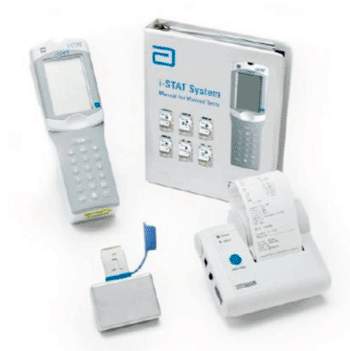Point-of-Care Device Compared for Cardiac Troponin Assay
By LabMedica International staff writers
Posted on 02 Oct 2013
A fingerstick point-of-care (POC) testing for cardiac troponin I has been compared to conventional venipuncture POC testing. Posted on 02 Oct 2013
Cardiac troponin assays commonly exceed one hour while point-of-care testing can be completed in minutes by basic life support personnel so when patients present complaining of chest pain, time can be critical to achieving positive outcomes.

Image: The i-STAT portable clinical analyzer system (Photo courtesy of Abbot Laboratories).
Scientists at the Loyola University Medical Center (Maywood, IL, USA) collected fingerstick blood samples from consenting patients for whom standard-of-care venipuncture POC troponin (POCT) testing had been ordered as part of their workup. Cardiac troponin (cTnl) assays were performed using a commercial device from June to August 2011. Eighty-nine cTnI levels were measured by both fingerstick and standard venipuncture emergency department POC testing. Four resulted in cartridge error so only the remaining 85 were analyzed.
Cardiac troponin I (cTnI) assays were performed using an i-STAT 1 device (Abbott Point of Care; Princeton, NJ, USA). Fingerstick testing, compared with standard ED POCT, has a positive predictive value of 1.00 (0.48, 1.00), a negative predictive value of 0.96 (0.89, 0.99), a sensitivity of 0.625 (0.24, 0.91), and a specificity of 1.00 (0.95, 1.00). The relationship between methods appeared to be linear.
The authors concluded that fingerstick cTnI testing using the i-STAT device is not accurate enough to determine the exact troponin level without the application of a corrective term. Fingerstick testing is, however, accurate in qualifying troponin levels as negative, borderline, or positive and is, therefore, capable of providing clinical information that may guide diagnostic and therapeutic decision-making. The study was published in the August 2013 issue of the American Journal of Emergency Medicine.
Related Links:
Loyola University Medical Center
Abbott Point of Care







 assay.jpg)





